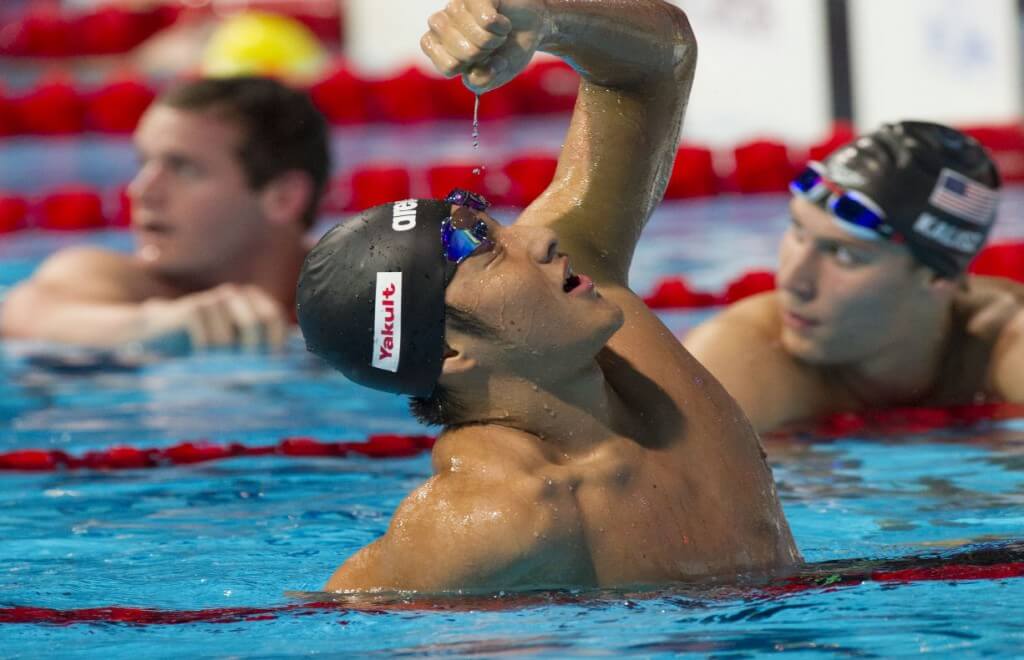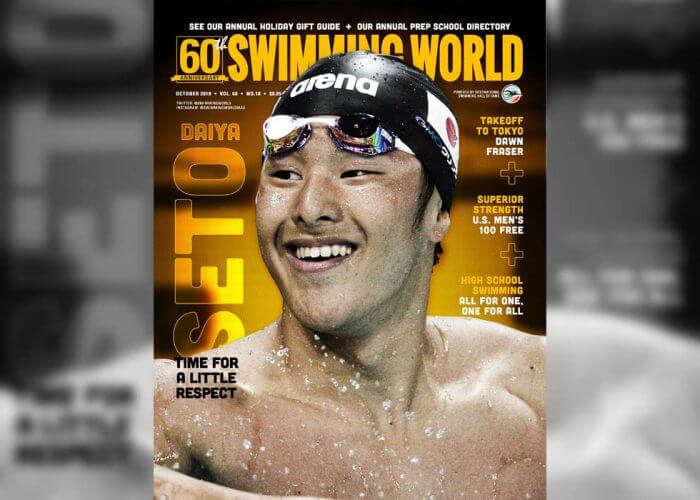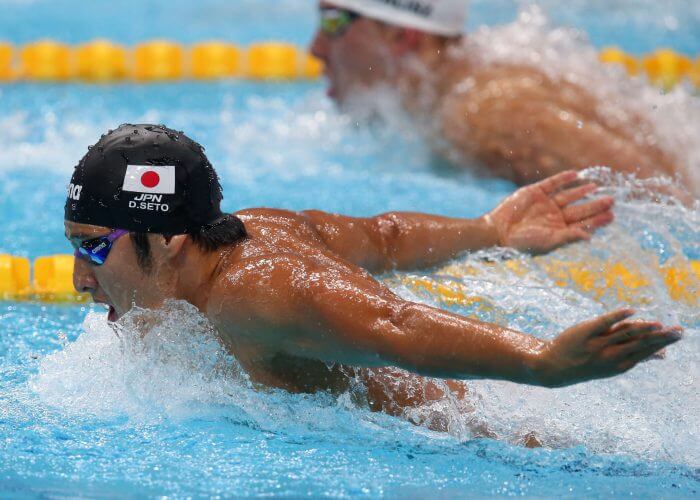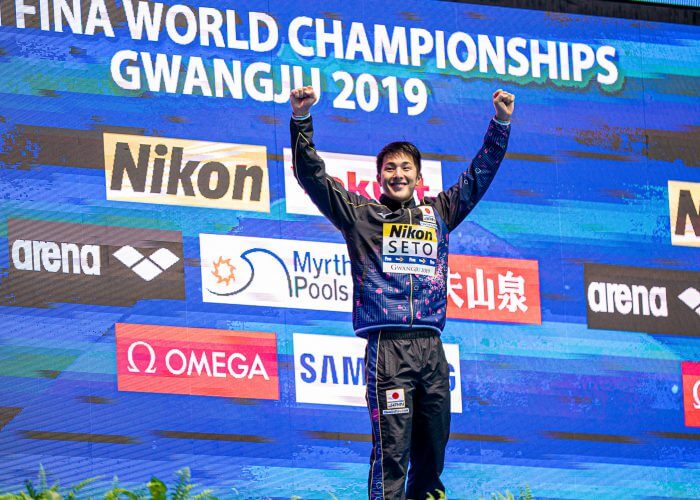Japan’s Daiya Seto Ranks Among the Sport’s Underappreciated Stars

Editorial content for the 2021 Tokyo Olympic Games coverage is sponsored by GMX7.
See full event coverage. Follow GMX7 on Instagram at @GMX7training #gmx7

Daiya Seto – Japan’s Multi-Event Star
He’s medaled at the Olympic Games. He’s a multi-time world champion, both on the long-course scene and in the little pool. He’s captured titles at the Pan Pacific Championships and Asian Games and stood on the top step of the podium at the World University Games. He’s also etched himself as a short-course world-record holder.
His versatility is among the finest on the planet, not surprising given his status as the current Man to Beat in the individual medley disciplines. Beyond what he does in the medley events, he’s one of the best in the world in the butterfly and displays first-class talent in the breaststroke. Simply put, guys like him are not often found.
So, how is it that Daiya Seto, a star by all measures, can be considered underappreciated while at the peak of his career? It is not to suggest Seto, a 25-year-old from Japan, is ignored when it comes to his achievements in the sport. It’s just that someone with his rich portfolio typically is celebrated on a grander scale.
As the 2020 Olympics in Tokyo quickly approach, Seto will have the opportunity to shine in his homeland. More, if he manages to succeed at the level he is capable, gone will be the days in which Seto does not receive his proper due.
A Summer of Excellence
The year before an Olympiad is always considered a launching pad. It is a chance to generate momentum and send a message to the competition. At last summer’s World Championships in Gwangju, Seto undoubtedly took advantage of the stage on which he performed, building his confidence on the road to Tokyo while simultaneously giving his foes someone to think about.
 Over the course of the eight-day competition, Seto made three trips to the medals stand, his last two visits leading to the highest point.
Over the course of the eight-day competition, Seto made three trips to the medals stand, his last two visits leading to the highest point.
Seto’s first final at Worlds unfolded in accordance with the under-the-radar nature of his career. Although Seto picked up the silver medal in the 200 butterfly, on the strength of a 1:53.86 clocking, few noticed his effort, or the bronze medal of South African Chad Le Clos. Why? Well, when the gold medalist obliterates a 10-year-old world record of Michael Phelps, as Hungarian Kristof Milak did with his outing of 1:50.73, little of the background is recognized.
For Seto, though, the 200 fly was just the start of a spectacular week. In his ensuing two events, Seto mined gold, first prevailing in the 200 individual medley and then capping his meet with victory in the 400 IM. Of those triumphs, the first marked a step forward, with the final triumph furthering Seto’s reputation.
When heats of the 200 medley started, Seto was among the medal contenders, although favorite status went to his American rival and defending champion, Chase Kalisz. By the time the three rounds were over, Seto had his first world title in the event, his personal best of 1:56.14 bettering the 1:56.56 of Swizterland’s Jeremy Desplanches and Kalisz, who touched the wall in 1:56.78. For Seto, his gold in the shorter medley served as proof of his global prowess in the event, complementing his already well-known status in the 400 IM. In a little less than two minutes, Seto made himself as much a factor in the shorter medley as the eight-lap discipline.
In the longer medley, Seto found himself in a different position. With Kalisz off form and stunningly locked out of the final after a 10th-place finish in the preliminaries, Seto was seemingly racing the clock in his final event of a draining week. Ultimately, Seto narrowly got the job done, his winning time of 4:08.95 just enough to fend off a frantic challenge by American Jay Litherland (4:09.22) down the final length of freestyle.
For Seto, his gold medal in the 400 IM marked his third title in the event in the last four World Championships, backing up previous wins in 2013 and 2015. In 2017, Seto also earned a medal, grabbing bronze, the same finish he secured at the 2016 Olympics. Still, Seto viewed his victory with a critical eye.
“I was lucky to win gold,” said Seto, who had an advantage of more than three seconds at the 300-meter mark. “I saw (Litherland). I tried to build up such a big lead that I could overcome any challenge. But not swimming well at the end (the freestyle leg) is an area of improvement for next year.”
In the Shadows
What Seto has accomplished is nothing short of impressive. At 5-foot-9 and 160 pounds, he is hardly an imposing figure, nor is he blessed with an Adonis-like physique that is regularly found in the sport. He is the epitome of a grinder, an athlete who attacks the training sessions devised by his personal coach, Takayuki Umehara.

Photo Courtesy: SIPA USA
Seto has also demonstrated a considerable amount of mental toughness, given what he experienced at the 2012 Japanese Olympic Trials. In pursuit of an invitation to the London Games, Seto was denied in the cruelest of ways, as he finished third in the 200 IM and 400 IM, a jolt that can severely stagger an athlete. But instead of letting his near miss linger, Seto used the experience as motivation, turning the disappointment into success.
The fact that Seto has not been as lauded as he rightfully deserves is not so much related to him as it is connected to the two men in his events who have been foes for several years – and who have garnered the majority of the attention. On his home turf, Seto has been overshadowed in the medley events by Kosuke Hagino, the reigning Olympic champion in the 400 individual medley. Even without a world title, as opposed to the collection Seto has put together, Hagino’s in-season excellence and routine fast times have led to more hype and expectations.
Even this past summer, Hagino was as much a discussion point as Seto – and Hagino wasn’t even in the water. Due to struggles with depression and a lack of desire to focus on his training, Hagino abandoned the 2019 campaign, a decision which became a major talking point and took some of the spotlight away from Seto. Would Hagino come back? If so, how quickly could he regain his form? Those were two of the questions that arose, instead of queries surrounding Seto’s in the-water exploits.
Meanwhile, Seto has also found himself in the shadow of Kalisz, the American who won both medley events at the 2017 World Championships and doubled again at the 2018 Pan Pacific Championships. With Kalisz hailing from the North Baltimore Aquatic Club, his storyline included a connection to Michael Phelps. Not only did Kalisz contest the medley events like Phelps, the 28-time Olympic Medalist is a big-brother type to Kalisz.
The combination of Hagino and Kalisz left Seto in the backseat and playing the role of the kid trying to be part of the front-seat conversation. Really, it was an unfair position for Seto, especially given his consistency. In long-course competition from 2013 through 2019, Seto has had the chance to medal in the 400 IM in international competition on seven occasions. He has converted on six of those chances, winning three gold medals and three bronze medals between the Olympics, World Championships and Pan Pacific Champs.
“I just try to focus on myself,” Seto said. “I focus on my training and doing what is required. I can only control what I do.”
Eye on Tokyo
As the Olympics in Tokyo approach, there is no question about Seto’s goal in his homeland: Capture Olympic gold. To make that dream a reality, Seto will likely take part in another clash with Hagino and Kalisz. While Hagino has resumed training and found a rekindled passion for the sport, Kalisz is no doubt motivated to erase the unpleasant memories of last summer’s World Championships.

Photo Courtesy: Becca Wyant
In the majority of his medal-winning outings in the 400 IM, Seto has battled with either Hagino or Kalisz, or both. The trio, however, has not developed any animosity toward one another. Rather, a healthy rivalry has emerged, one defined by mutual respect and admiration.
“We’ve been racing one another since 2011 and just about every progression I’ve gone through from the junior team to the national team, (Seto) and (Hagino) have been there,” Kalisz said. “We’ve developed a pretty good friendship and unique rivalry.”
Seto wasted little time getting back to work after the World Champs, opting to compete in World Cup action instead of taking what would have been a well-deserved break. Considering that Seto has automatic berths to the Olympics in the medley events, thanks to his world crowns, his decision to not regroup after Gwangju only speaks to Seto’s laser focus and hunger for Olympic glory.
A sub-minute performer in the 100 breaststroke and among the world’s elite stars in the butterfly, Seto features a pair of overwhelming legs in his medley arsenal. What requires work, and is readily recognized by Seto, is his freestyle leg. Instead of having to hold off a rival, as was the case with Litherland at the World Champs, Seto is working on his finishing power. He’s also targeted a time in the 4:05 range as necessary for gold. In the history of the 400 IM, only Phelps, Ryan Lochte and Kalisz have ever gone under 4:06. Seto owns a personal best of 4:07.95, so a sizable drop is necessary for his target time to be met.
“From here on out, I’m focused on (the Olympics),” Seto said. “In order for me to swim in the 4:05s, I need to work on my freestyle. At the Olympics, I’d like to make sure I swim in the 4:05s so I’ll have a legitimate chance to win. I’m determined to overcome grueling training, so I’ll be ready for next year.”
Rightful Respect
For someone to boast four world titles and seven individual medals from the World Championships, the instant assumption is that he stands out as one of the biggest names in the sport. Sure, Daiya Seto is respected by his rivals and generally around the pool, but his exploits are greater than the recognition that is given.
Sometimes, a low-key demeanor is lost amid the chest-thumping types, those who chirp a little louder than the rest, or athletes surrounded by controversy. But let’s get one thing straight as the Olympic Games in Tokyo call: Seto is a special talent and deserves every bit of respect that comes his way – even if it follows an all-too-long delay.




